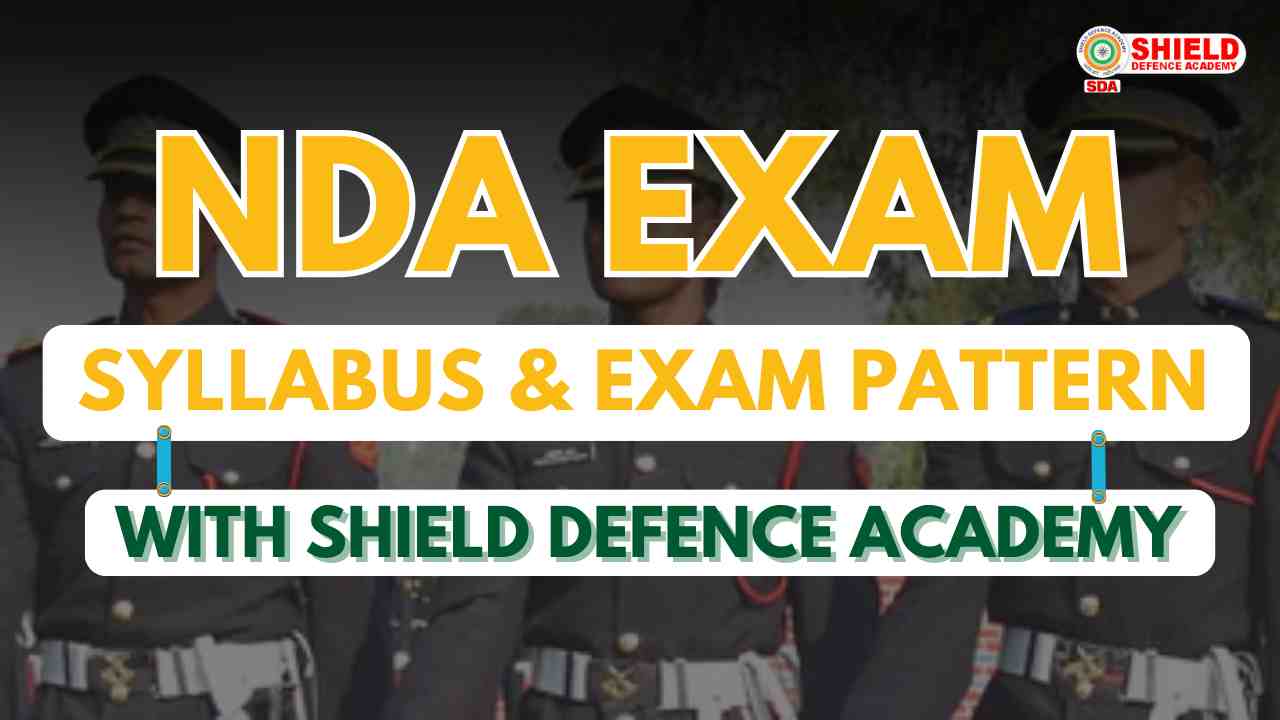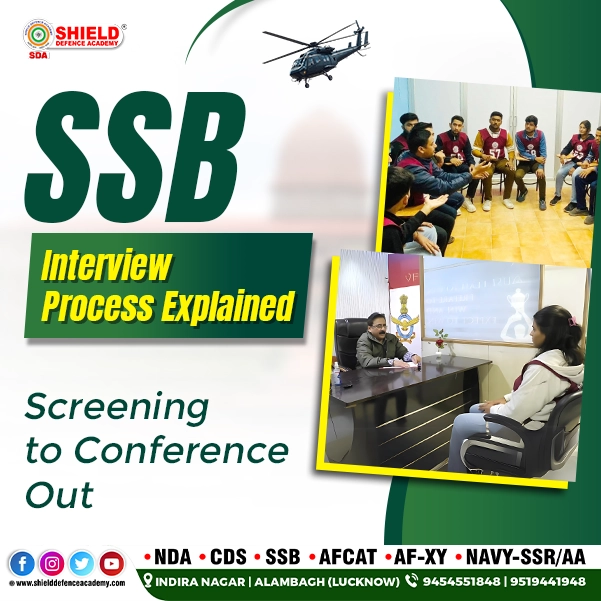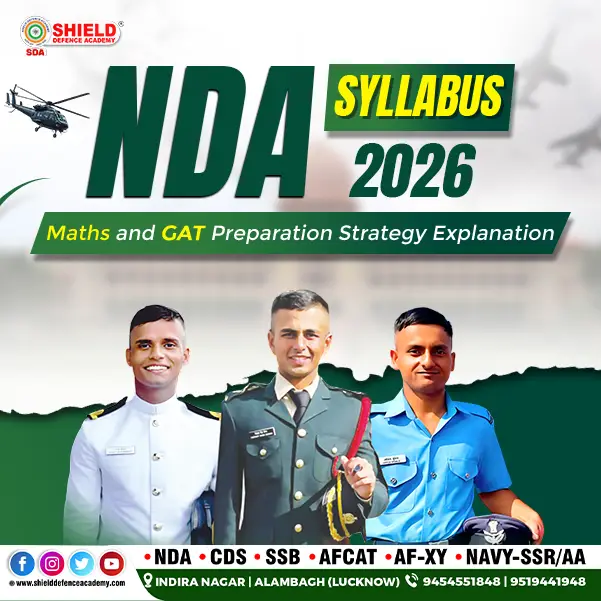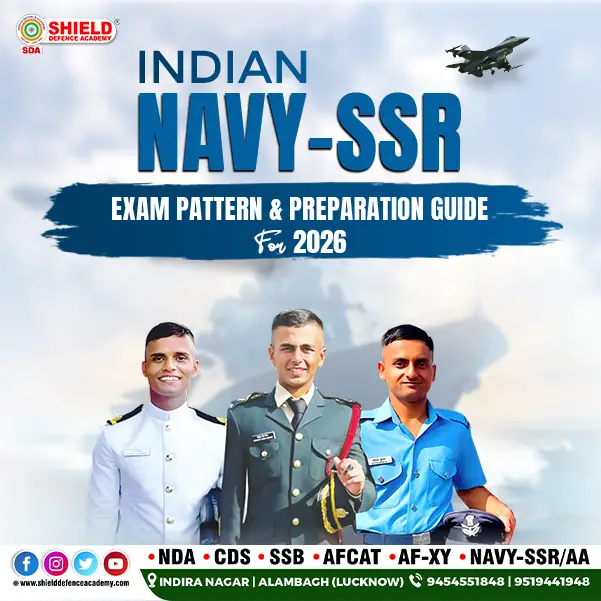NDA Syllabus and exam pattern 2024 by Shield Defence Academy
The NDA exam is conducted by the UPSC (Union Public Service Commission) board. It held a twice in a year. So here we will describe you about NDA syllabus and exam pattern ,The NDA exam is divided into two phases-
1.Written
2.SSB Interview
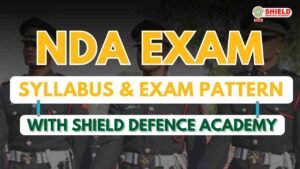
Written exam consist of two paper-
Mathematics(300 marks) is important for NDA syllabus and exam pattern
MATRICES AND DETERMINANTS
Types of matrices, operations on matrices.
Determinant of a matrix, basic properties of determinants.
Adjoint and inverse of a square matrix, Applications-Solution of a system of linear equations in two or three unknowns by Cramer’s rule and by Matrix Method.
DIFFERENTIAL CALCULUS
Concept of a real valued function–domain, range and graph of a function.
Composite functions, one to one, onto and inverse functions.
Notion of limit, Standard limits—examples.
STATISTICS AND PROBABILITY
Classification of data, Frequency distribution, cumulative frequency distribution—examples.
Graphical representation—Histogram, Pie Chart, frequency polygon— examples.
Union and Intersection of Events.
Complementary, elementary and composite events.
ALGEBRA
Concept of set, operations on sets, Venn diagrams.
De Morgan laws, Cartesian product, relation, equivalence relation.
Representation of real numbers on a line.
TRIGONOMETRY
Angles and their measures in degrees and in radians.
Trigonometric ratios.
Trigonometric identities Sum and difference formulae.
ANALYTICAL GEOMETRY OF TWO AND THREE DIMENSIONS
Rectangular Cartesian Coordinate system.
Distance formula.
Equation of a line in various forms.
VECTOR ALGEBRA is most important in NDA syllabus and exam pattern
Vectors in two and three dimensions, magnitude and direction of a vector.
Unit and null vectors, addition of vectors, scalar multiplication of a vector, scalar product or dot product of two vectors.
Vector product or cross product of two vectors.
INTEGRAL CALCULUS AND DIFFERENTIAL EQUATIONS
Integration as inverse of differentiation, integration by substitution and by parts, standard integrals involving algebraic expressions, trigonometric, exponential and hyperbolic functions.
Evaluation of definite integrals—determination of areas of plane regions bounded by curves—applications.
Definition of order and degree of a differential equation, formation of a differential equation by examples.
GAT(600 marks) is a part of NDA syllabus and exam pattern
General ability test consist of –
English
1.Spotting Error
2.Comprehension
3.Selecting Words
4.Synonyms
5.Antonyms
6.Sentence Improvement
7 Ordering of Words in a Sentence
Physics
1.Physical Properties and States of Matter
2.Modes of transference of Heat
3.Mass, Weight, Volume, Sound waves and their properties
4.Simple musical instruments
5.Rectilinear propagation of Light
6.Density and Specific Gravity
7.Reflection and refraction
8.Principle of Archimedes
9.Spherical mirrors and Lenses
10.Pressure Barometer
11.Human Eye
12.Motion of objects
13.Natural and Artificial Magnets
14.Velocity and Acceleration
15.Properties of a Magnet
16.Newton’s Laws of Motion
17.Earth as a Magnet
18.Force and Momentum
19.Static and Current Electricity
20.Parallelogram of Forces
21.Conductors and Non-conductors
22.Stability and Equilibrium of bodies
23.Ohm’s law
24.Gravitation
25.Simple Electrical Circuits
26.Elementary ideas of work
27.Heating, Lighting, and Magnetic effects of 28.Current
29.Power and Energy
30.Measurement of Electrical Power
31.Effects of Heat
32.Primary and Secondary Cells
33.Measurement of Temperature and Heat
34.Use of X-Rays
35.General Principles in the working of Simple Pendulum
Chemistry
1.Preparation and Properties of Hydrogen, Oxygen, Nitrogen and Carbon Dioxide, Oxidation and Reduction.
2.Acids, bases and salts.
3.Carbon— different forms
4.Physical and Chemical Changes
5.Fertilizers—Natural and Artificial
6.Elements
7.Material used in the preparation of substances like Soap, Glass, Ink, Paper, Cement, Paints, Safety Matches, and Gunpowder
8.Mixtures and Compounds
9.Elementary ideas about the structure of Atom
10.Symbols, Formulae, and simple Chemical Equation
11.Atomic Equivalent and Molecular Weights.
12.Law of Chemical Combination (excluding problems)
13.Valency
14.Properties of Air and Water
General Science
1.Common Epidemics, their causes, and prevention
2.Difference between the living and non-living
3.Food—Source of Energy for man
4.Basis of Life—Cells, Protoplasms, and Tissues
5.Constituents of food
6.Growth and Reproduction in Plants and Animals
7.Balanced Diet
8.Elementary knowledge of the Human Body and its important organs
9.The Solar System—Meteors and Comets, Eclipses.
History
1.Forces shaping the modern world;
2.Renaissance
3.exploration and Discovery;
4. broad survey of Indian History, with emphasis on Culture and Civilisation
5.freedom Movement in India
6.french Revolution, Industrial Revolution, and Russian Revolution
7.War of American Independence,
8.Impact of Science and Technology on Society
9.Elementary study of Indian Constitution and Administration
10.Concept of one World
11.Elementary knowledge of Five Year Plans of India
12.United Nations,
13.Panchsheel,
14.Panchayati Raj, Democracy, Socialism and Communism
15.Role of India in the present world
16.Co-operatives and Community Development
17.Bhoodan, Sarvodaya,
18.National Integration and Welfare State
19.Basic Teachings of Mahatma Gandhi
Geography
1.The Earth, its shape and size
2.Ocean Currents and Tides Atmosphere and its composition
3.Latitudes and Longitudes
4.Temperature and Atmospheric Pressure, Planetary Winds, Cyclones, and Anticyclones; Humidity; Condensation and Precipitation
6.Concept of time
7.Types of Climate
8.International Date Line
9.Major Natural Regions of the World
10.Movements of Earth and their effects
11.Regional Geography of India
12.Climate, Natural vegetation. Mineral and Power resources;
13.Location and distribution of agricultural and Industrial activities
14.Origin of Earth. Rocks and their classification
15.Important Sea ports and main sea, land, and air routes of India
16.Weathering—Mechanical and Chemical, Earthquakes and Volcanoes
17.Main items of Imports and Exports of India
Current affairs
1.Knowledge of Important events that have happened in India in recent years.
2.Prominent personalities of both Indian and International level
3.Cultural activities and sports activities
4.Current important world events.
SSB(Service Selection Board)(900 marks)
Day 1. Screening Test
OIR(Officer’s Intelligence Rating Test)
Verbal Reasoning
Non- Verbal Reasoning
PP &DT(Picture Perception and Description Test)
Story Narration
Common Story Discussion
Day 2.Psychology Test
TAT(Thematic Appreception Test)
WAT(Word Association Test)
SRT(Situation Reaction Test)
SDT(Self description Test)
Day 3&4
GTO
Indoor
GD ( Group Discussion)
GPE(Group planning exercise)
Outdoor
PGT( Progressive Group Task)
HGT(Half Group Task)
Snake Race
Command Task
Individual Obstacles
Final Group Task
Day 5
Conference
Result
Medical
Merit List
Selected
Conclusion for NDA syllabus and exam pattern
Shield Defence Academy has announced that the NDA exam for 2024 would contain Mathematics and General Ability Test (GAT) papers. The Mathematics paper includes a variety of topics, including algebra, trigonometry, calculus, and statistics. The GAT test measures English competence and general knowledge in disciplines such as physics, history, and current events. Success on the NDA exam necessitates extensive study for both the written examination and the subsequent SSB interview. Good luck with your academics and exam preparation!
